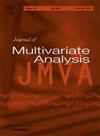Fisher’s legacy of directional statistics, and beyond to statistics on manifolds
IF 1.4
3区 数学
Q2 STATISTICS & PROBABILITY
引用次数: 0
Abstract
It is not an exaggeration to say that R.A. Fisher is the Albert Einstein of Statistics. He pioneered almost all the main branches of statistics, but it is not as well known that he opened the area of Directional Statistics with his 1953 paper introducing a distribution on the sphere which is now known as the Fisher distribution. He stressed that for spherical data one should take into account that the data is on a manifold. We will describe this Fisher distribution and reanalyze his geological data. We also comment on the two goals he set himself in that paper, and on how he reinvented the von Mises distribution on the circle. Since then, many extensions of this distribution have appeared bearing Fisher’s name such as the von Mises–Fisher distribution and the matrix Fisher distribution. In fact, the subject of Directional Statistics has grown tremendously in the last two decades with new applications emerging in life sciences, image analysis, machine learning and so on. We give a recent new method of constructing the Fisher type distributions on manifolds which has been motivated by some problems in machine learning. The number of directional distributions has increased since then, including the bivariate von Mises distribution and we describe its connection to work resulting in the 2024 Nobel-winning AlphaFold (in Chemistry). Further, the subject has evolved as Statistics on Manifolds which also includes the new field of Shape Analysis, and finally, we end with a historical note pointing out some correspondence between D’Arcy Thompson and R.A. Fisher related to Shape Analysis.
费雪的方向统计的遗产,以及对流形的统计
毫不夸张地说,R.A.费雪是统计学的爱因斯坦。他开创了统计学的几乎所有主要分支,但不为人所知的是,他在1953年的论文中引入了球上的分布,即现在被称为费雪分布,从而开辟了方向统计领域。他强调,对于球形数据,应该考虑到数据是在流形上的。我们将描述这种费雪分布并重新分析他的地质数据。我们还评论了他在那篇论文中为自己设定的两个目标,以及他如何在圆上重新发明了冯·米塞斯分布。从那时起,这个分布的许多扩展都以费雪的名字出现了,比如冯米塞斯-费雪分布和矩阵费雪分布。事实上,在过去的二十年里,随着生命科学、图像分析、机器学习等领域的新应用的出现,方向统计的学科得到了极大的发展。本文给出了一种构造流形上Fisher型分布的新方法,该方法是由机器学习中的一些问题所激发的。从那时起,方向分布的数量增加了,包括二元冯米塞斯分布,我们描述了它与2024年诺贝尔奖得主阿尔法fold(化学)的工作之间的联系。此外,该学科已演变为流形统计,其中还包括形状分析的新领域,最后,我们以历史注释结束,指出D 'Arcy Thompson和R.A. Fisher之间与形状分析相关的一些通信。
本文章由计算机程序翻译,如有差异,请以英文原文为准。
求助全文
约1分钟内获得全文
求助全文
来源期刊

Journal of Multivariate Analysis
数学-统计学与概率论
CiteScore
2.40
自引率
25.00%
发文量
108
审稿时长
74 days
期刊介绍:
Founded in 1971, the Journal of Multivariate Analysis (JMVA) is the central venue for the publication of new, relevant methodology and particularly innovative applications pertaining to the analysis and interpretation of multidimensional data.
The journal welcomes contributions to all aspects of multivariate data analysis and modeling, including cluster analysis, discriminant analysis, factor analysis, and multidimensional continuous or discrete distribution theory. Topics of current interest include, but are not limited to, inferential aspects of
Copula modeling
Functional data analysis
Graphical modeling
High-dimensional data analysis
Image analysis
Multivariate extreme-value theory
Sparse modeling
Spatial statistics.
 求助内容:
求助内容: 应助结果提醒方式:
应助结果提醒方式:


